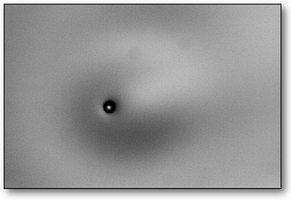
Top view of a walker moving towards the bottom left.
Millimeter-sized droplets can be sustained on top of liquid surfaces that are subject to vertical vibrations. At vibration frequencies close to the Faraday instability, such droplets are observed to “walk”, i.e. to undergo horizontal motion on the liquid surface. This is due to their interaction with the surface waves that they generate when bouncing off the liquid. Within confined geometries, the complex scattering of surface waves forces the motion of each individual droplet to be chaotic. Nevertheless, it is surprisingly observed that a statistical average over the droplet positions yields the same probability distribution as the one that would be expected for a quantum particle described by a wavefunction. In particular, the characteristic double-slit interference pattern was experimentally observed with individual droplets that propagated through a two-slit scattering geometry. This result is the starting point of a possible analogy between the motion of a droplet interacting with its surface wave and the dynamics of a quantum particle that is, in the Bohmian interpretation of quantum mechanics, piloted by its associated wave function.
The aim of our cooperative research project is to explore and put forward the analogy between classical droplets and Bohm’s pilot-wave theory in more detail, both theoretically and experimentally. We intend to push it to the ultimate limits of correspondence, and possibly to extend it to the realm of few- and many-particle quantum physics. Experimental investigations of the motion of walkers within complex scattering geometries shall be complemented and supported by numerical simulations of the dynamics of the droplets and their surface waves as well as by quantum theoretical investigations of their analogy with Bohmian quantum mechanics.